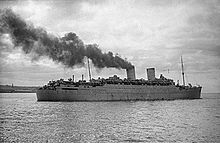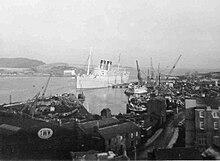RMS Mauretania (ship, 1939)
|
The RMS Mauretania , 1938
|
||||||||||||||||||||||||||
|
||||||||||||||||||||||||||
|
||||||||||||||||||||||||||
|
||||||||||||||||||||||||||
|
||||||||||||||||||||||||||
|
||||||||||||||||||||||||||
|
||||||||||||||||||||||||||
The RMS Mauretania was the second ship of the Cunard shipping company to bear this name. It was in service from 1939 to 1965.
Ship life
Pre-war period
In the 1930s, the Cunard fleet had to be rejuvenated on the standard route to New York . The decision was made for a larger ship than the one previously used there. It should have well-equipped cabins and - because not as fast as the ships on the express route - be economical to operate. Nevertheless, the ship still had to be fast enough to be able to step in for the express service if one of the two “queens” ( Queen Mary and Queen Elizabeth ) failed. It should also for cruises be suitable. Such a ship was commissioned from Cammell, Laird & Company in Birkenhead . It was launched on July 28, 1938 and was completed in May 1939. The sea trials were carried out on May 31st and the ship left Liverpool on its maiden voyage .
Although built for the less prestigious normal service to New York, the Mauretania was one of the largest ships of the time.
On the return voyage, the 1,300-passenger ship headed for Southampton and ran from there to London , where she was the largest ship that had ever come up the Thames to King George V Dock . She left London again on April 11, 1939, ran to New York and back to Southampton, where she arrived on September 3. On September 14, the Mauretania ran again to New York, but has now returned to Liverpool, where it was initially launched . On December 10th, she ran again towards New York and stayed there. After the outbreak of World War II , it was considered safer to hang them there for the time being. The two “queens” and French Normandy were also moored there.
Military service
On March 6, 1940, the British Royal Navy pulled in the Mauretania as a troop transport. After quickly carried out conversion work, she ran out in the direction of Sydney , crossed the Panama Canal and passed Honolulu . The conversion work was completed in Sydney. The ship drove in a convoy with 2000 Australian soldiers on board towards Glasgow . This was her occupation for the next six years. She also drove in WS convoys .
In the years 1940-42 the Mauretania mostly sailed between Australia / New Zealand and the Middle East. The famous passenger steamers Nieuw Amsterdam and the Île de France could also be found on these routes . Due to their high speed, these ships could also sail without escort, whereby they additionally protected themselves through a zigzag course.
For the North African campaign, she returned to her traditional trading area and brought American and Canadian soldiers across the Atlantic to the Mediterranean . In 1943 she completed no fewer than 21 Atlantic crossings.
The ship's engines had worked perfectly all through the war years, propelling the ship forward at up to 25 knots . In total, she has covered 540,000 nautical miles in the naval service and transported 350,000 members of the armed forces.
A minor accident happened on January 8, 1944. In the port of New York she collided with the tanker Hat Creek. The damage was only minor and could be repaired within 24 hours.
post war period
The overhaul work on the Mauretania after the naval operation lasted around eight months. Much of its old facilities were brought together from America and Australia, where they had been stored, and in April 1947 she returned to her traditional sailing area , the North Atlantic , as a merchant ship .
The first departure was on April 26th from Liverpool. Southampton soon became the base port for the ship, which would again become a fixture on the transatlantic route for the next few years .
During the winter months, the ship made cruises from New York. These led to Nassau , La Guaira , Curaçao , Colón and Havana .
When the first commercial jet aircraft began their service in 1958, ship travel across the Atlantic lost its importance. In February 1962, the Mauretania made her first cruise to the Mediterranean from New York. A year later, now painted in "cruise green", attempts were made to open a line from Naples to New York via Genoa , Cannes and Gibraltar . However, this turned out to be a flop, because the ship, which was now getting on in years, could hardly keep up with the modern and fast Italian and American passenger ships. It was also out of fashion as a cruise ship.
In 1964 and 1965 she continued to cruise and line from Southampton to New York. Her last cruise was from New York to the Mediterranean and Black Seas . This lasted 56 days and ended on November 10, 1965 in Southampton. Her departure was announced during the trip. On November 20, she left Southampton for the last time en route to demolition in Inverkeithing , where she was joined by the demolition company Thomas W. Ward Shipbreakers Ltd. was scrapped.
Regular scheduled services
- Liverpool – New York
- Southampton-New York
Web links
literature
- Andrew Britton: RMS Mauritania . The History Press Ltd., 2013, ISBN 978-0752479507 .


